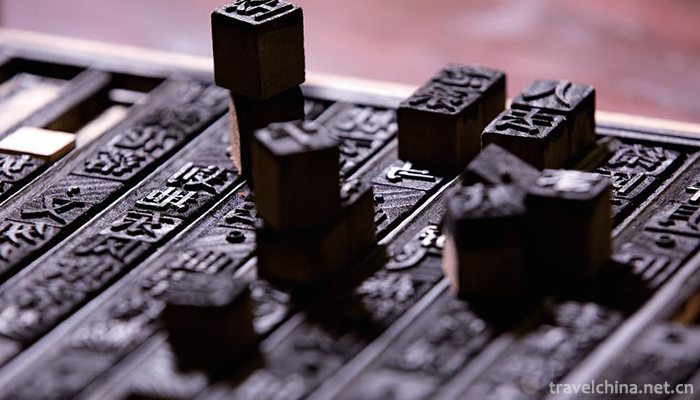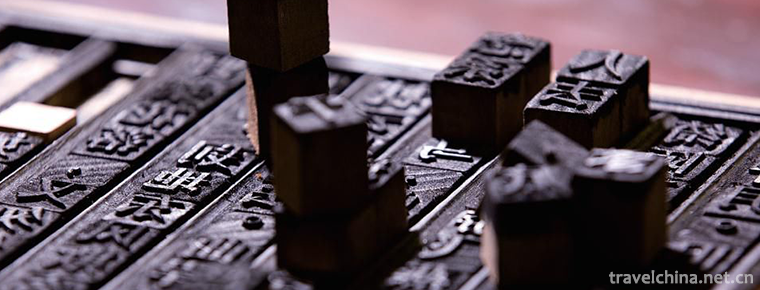Wood movable type printing technology
Wood movable type printing technology
Wood movable type printing technology, the local traditional technology of Ruian City, Zhejiang Province, is one of the national intangible cultural heritage.
Dongyuan Village is located in the southwest of Ruian City, Zhejiang Province. According to the local "Wang's genealogy of Taiyuan County", in the early Yuan Dynasty, Wang Famao, a hermit in Anxi County, Fujian Province, began to introduce the technology of wood movable type printing into the genealogy compilation of clans (clans). The art of "Zi Ji" (the process of using wood movable type printing to compile genealogy) came into being and has been inherited from generations to generations. During the reign of Zhengde in Ming Dynasty, some descendants of Wang Famao moved from Fujian to Pingyang in Zhejiang Province. In the first year of Qianlong in the Qing Dynasty (1736), Wang Famao V's grandson Yingzhong led his descendants from Pingyang to Dongyuan. The art of Ziji took root in Dongyuan and has been handed down to this day.
In June 2008, wood movable type printing technology was approved by the State Council and listed in the second batch of national intangible cultural heritage list, project number_-135. On November 15, 2010, Rui'anmu movable-type printing technology, in the name of Chinese movable-type printing, was listed on the list of "the urgent need to protect intangible cultural heritage" in the world.
historical origin
According to the genealogy of Wang clan in Taiyuan County, the ancestors of Wang clan originally lived in Henan Province. At the end of the Five Dynasties, Wang Chao and Wang Juzhi brothers moved to Fujian, and then one of them moved to Anxi County, Fujian Province. In the early Yuan Dynasty, Wang Famao, who lived in seclusion in Taili, Anxi County, Fujian Province, began compiling genealogy and printing genealogy in movable wood. From then on, Wang's "Zi Ji" (printing and editing) art came out. During the reign of Ming Zhengde (1506-1521), some descendants of Wang Famao moved from Fujian to Puwei and Xiangyuan of Pingyang, Zhejiang. In the first year of Qianlong (1736), Wang Yingzhong led his descendants from Pingyang Xiangyuan to Ruian Dongyuan. Wang Famao's "Zi Ji" art took root in Dongyuan Village and was inherited from dynasties to dynasties. The enlightened Wang genealogist imparted his skill of printing and printing genealogy with wood movable type to his relatives and friends in the same village, and even to scholars in other counties. In this way, Wu, Pan, Zhang and other surname residents also learned the art of "Zi Ji".
Technological characteristics
Re-assembly leads to the reuse of layout components, so printing the same text or graphics on different pages is the unique technological feature of movable type typesetting which is different from other printing methods. The inner parts of movable-type plate, such as top wood and clamping strips, sometimes leave traces on the plate, which is also the unique technological characteristics of movable-type printing.
Technological process
Wood movable type printing is closely related to the compilation of genealogy. The basic production process is: Kaiding (interview) clearing drafting checking typesetting proofreading brushing circle scribbling typesetting drafting spectrum cutting binding line cover binding. Usually, we need to do a good job in the basic work of drawing materials, making fonts, writing (opposite fonts), engraving and so on. Take a good tangerine pear wood, after rain, sun and natural drying, make a type, engrave Song style, and make one by one wooden movable characters for typesetting.
Inheritance and Protection
Inheritance value
Ruian Wood Movable Type Printing is the only known and still used technology of Wood Movable Type Printing in China. It has a good historical and humanistic value and is a physical proof that Movable Type Printing originated in China.
Current situation of inheritance
With the rapid development of mechanized printing, there are few successors of Dongyuan wood movable-type printing technology, such as engraving, printing and so on. It is on the verge of extinction and needs to be protected urgently.
Heritage figures
Lin Chuyin, male, was born in April 1938. In April 2010, Lin Chuyin was selected as the representative successor of the third batch of national intangible cultural heritage projects: wood movable type printing technology.
Wang Chaohui, male, was born in December 1955. In April 2010, Wang Chaohui was selected as the representative successor of the third batch of national intangible cultural heritage projects: wood movable type printing technology.
protective measures
In June 2004, Ruian City built the first Chinese Wood Movable Type Printing Culture Exhibition Hall (old hall), 13 years later, the new hall was completed. The new exhibition hall covers an area of 540 square meters and a building area of 1013 square meters. The whole exhibition hall has reception rooms, exhibition halls, exhibition halls for the whole process of wood movable type printing, visitor experience halls and so on. It fully demonstrates the whole operation process of the ancient "wood movable type printing".
social influence
Important exhibitions
On June 9, 2007, Wenzhou Municipal Exhibition Hall exhibited "Wenzhou Rural Ethnic Folk Art Exhibition". Some old folk traditions gradually fading out of people's lives appeared before you. Ruian's "movable-type printing" exhibition has become the highlight of the first Wenzhou Peasant Culture and Art Festival.
Social activities
On November 27, 2017, Ruian City held a seminar on the cultural industry and tourism development of wood movable type printing in China (Ruian). At the seminar, Dr. Zhang Ji, Director of Institute of Modern Publishing, School of Journalism and Communication, Peking University, Ms. Zhao Chunying, Director of Collection Management and Associate Research Librarian of China Printing Museum, Dr. Peng Junling, Research Librarian of Beijing Printing College, Wang Xiaoming, Associate Professor of China Academy of Fine Arts, Master Tutor, and Hu Nianwang, Director of Office of Wenzhou Tourism Bureau, made "Zhejiang Province". With Ancient Movable-type Printing, New Times, New Objectives of Traditional Culture Development: Reflections on Renovation of the Exhibition Hall of Dongyuan Chinese Wood Movable-type Printing Culture Village, Thoughts on Protection, Inheritance and Development and Utilization of Wood Movable-type Printing, Civilization Inheritance and Future Hope: Multi-interaction between Chinese Wood Movable-type Printing and Contemporary Chinese Character Ink Art, and Wood Mova Speech on the theme of "Tourism Industry Development".


-
1.Guanmenshan National Forest Park
Guanmenshan National Forest Park is located 70 kilometers southeast of Benxi City. The Forest Park covers an area of 3517 hectares, with an altitude of 310-1234 meters and a forest coverage
Time 2018-12-24 -
2.Guyuan Northern Dynasty Sui and Tang Dynasties Cemetery
The tombs of the Northern Dynasty and Sui and Tang Dynasties in Guyuan are located in Xiaomazhuang, Yangfang, Shengou, Dabao, Wanglioba, five natural villages in the West and south suburbs of Yuanzhou
Time 2019-01-12 -
3.Shanshan guild hall
Shanxi-Shaanxi Guild Hall is the place where Shanxi and Shaanxi merchants and businessmen associate with each other and worship gods. It combines exquisite architectural
Time 2019-02-08 -
4.Sacrifice forest
Sacrifice to the gods of villages, as well as "Amaron" and "Pumatu" and other names, is a traditional festival of the Hani people, which takes villages as units and integrates reli
Time 2019-05-05 -
5.Longyan tea lamp
Longyan tea-picking lamp, also known as tea-picking and butterfly-beating, is a popular folk dance and singing in Longyan city and countryside. It integrates rap, opera and dance into a comprehensive
Time 2019-05-14 -
6.Wood carving
Wood sculpture is a kind of sculpture, which is often called "folk craft" in our country. Wood carving can be divided into three categories: solid round carving, root carving and relief carv
Time 2019-06-06 -
7.Shannan Menba Opera
Because Shannan Menba Opera directly adopts Tibetan scripts of Tibetan Opera, it is called "Menba Aguiram" by the people, that is, Menba Tibetan Opera. Legend has it that at the end of the 1
Time 2019-06-13 -
8.Taohuawu Wood Engraving New Year Picture
Taohuawu New Year Picture is a Folk Woodcut New Year Picture in the south of the Yangtze River. It was named for its production in the area of Taohuawu in Suzhou. It and the woodcut New Year pictures
Time 2019-06-18 -
9.Ziyang Folk Songs
Ziyang Folk Song is the general name of traditional folk songs spread in Ziyang County, Shaanxi Province, and it is the most representative of traditional folk songs in southern Shaanxi Province. It h
Time 2019-08-16 -
10.Former residence of Wu Yuzhang
Wu Yuzhang's former residence is located in group 6, caijiayan village, Shuangshi Town, Rong County, Zigong City, Sichuan Province. It is 14km away from the county seat and 32km away from Zigong City.
Time 2020-10-15 -
11.Deyang cultural undertakings
As of the end of 2018, Deyang City has 7 public libraries with a total collection of 1189.8 thousand books (pieces). The city has 7 cultural centers, 127 cultural stations, 10 museums, 48 art performing groups, and 27 theaters and cinemas. By the end of the year,
Time 2020-12-14 -
12.Yibin science and technology
In 2019, there are 34 new high-tech enterprises, 13 provincial science and technology achievements transfer and transformation demonstration enterprises, 2 provincial science popularization bases and 6 Municipal Science Popularization base
Time 2020-12-18